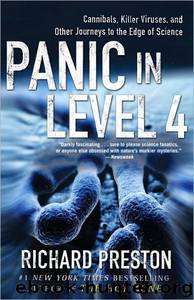Panic in Level 4 by Richard Preston

Author:Richard Preston [Preston, Richard]
Language: eng
Format: epub
ISBN: 9780812975604
Amazon: 081297560X
Barnesnoble: 081297560X
Publisher: Random House
Published: 2008-05-27T00:00:00+00:00
3. Identification
IN PAVILION THREE of the Kikwit General Hospital, Dr. Mpia Bwaka collected samples of blood from fourteen of his patients. Somebody drove the samples over the terrible road to Kinshasa. From there, the blood samples were flown to a laboratory in Belgium. The Belgian scientists, fearing that the blood might be dangerous, sent them along to the Centers for Disease Control and Prevention in Atlanta—the CDC. The fourteen tubes of blood from Pavilion Three ended up in the Biosafety Level 4 hot zone of the Special Pathogens Branch, where a researcher named Ali S. Khan, working along with several colleagues, identified Ebola virus in all fourteen of the test tubes. It was a new type of Ebola virus, and it would eventually be named Ebola Kikwit.
As it happened, just at that time, another new type of Ebola was causing an outbreak in Ivory Coast, in West Africa. This type of the virus would eventually be named Ebola Ivory Coast. Thus two outbreaks of different types of Ebola occurred almost simultaneously in different places, which deepened the mystery over the origin of Ebola. Why and how was Ebola emerging in different places? A medical team from the World Health Organization, in Geneva, was preparing to fly to Ivory Coast, in West Africa, to investigate.
The WHO Ebola Ivory Coast team was led by Bernard Le Guenno, a scientist from the Institut Pasteur in Paris, and by Pierre Rollin, a French virologist who was then stationed at the CDC in Atlanta. But with the large outbreak happening in Congo, which needed immediate attention, Bernard Le Guenno and Pierre Rollin were sent to Congo instead, where they joined a ten-member WHO team of doctors from France, Congo, the United States, and South Africa.
The Ivory Coast Ebola case had occurred about a month before G.M. got sick—he was the first person known to have Ebola Kikwit. In Ivory Coast, a woman scientist from Switzerland (whose name has never been publicly disclosed) was studying a troop of wild chimpanzees in Taï National Park. The Taï Forest was one of the last pristine rain forests in West Africa. The troop of chimpanzees became infected with a mysterious disease, and many of them died. The Swiss woman, extremely concerned about her chimps, dissected one of the dead animals, trying to find out what had killed it. Soon afterward, she developed a rash and became severely ill, and she began having hemorrhages. She developed the symptoms of Ebola virus.
For unknown reasons, Ebola had been getting into chimpanzees. Chimps and other great apes, such as bonobos and gorillas, are probably not natural hosts of Ebola virus. This is because Ebola makes the apes extremely sick—as sick as humans become with the virus. (The western gorilla is presently very threatened by Ebola virus, and many gorillas have died in Congo from outbreaks of Ebola among them. No one knows how the gorillas are getting Ebola, but some wildlife biologists fear that Ebola could help cause the western gorilla’s extinction.) The
Download
This site does not store any files on its server. We only index and link to content provided by other sites. Please contact the content providers to delete copyright contents if any and email us, we'll remove relevant links or contents immediately.
Born to Run: by Christopher McDougall(7064)
The Leavers by Lisa Ko(6910)
iGen by Jean M. Twenge(5366)
Sapiens by Yuval Noah Harari(5293)
The Kite Runner by Khaled Hosseini(5081)
Spare by Prince Harry The Duke of Sussex(5072)
Machine Learning at Scale with H2O by Gregory Keys | David Whiting(4170)
Bullshit Jobs by David Graeber(4094)
Never by Ken Follett(3787)
Goodbye Paradise(3724)
Livewired by David Eagleman(3682)
Fairy Tale by Stephen King(3216)
A Dictionary of Sociology by Unknown(3018)
Harry Potter 4 - Harry Potter and The Goblet of Fire by J.K.Rowling(2984)
The Social Psychology of Inequality by Unknown(2936)
The Club by A.L. Brooks(2862)
Will by Will Smith(2789)
0041152001443424520 .pdf by Unknown(2783)
People of the Earth: An Introduction to World Prehistory by Dr. Brian Fagan & Nadia Durrani(2701)
